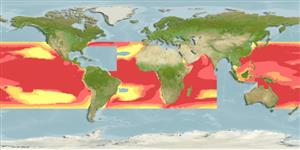Pseudocarcharias kamoharai (Matsubara, 1936)
Crocodile shark
個人による観察記録の追加 Fish Watcher
| Native range | All suitable habitat | Point map | Year 2050 |

|
| This map was computer-generated and has not yet been reviewed. |
| Pseudocarcharias kamoharai AquaMaps Data sources: GBIF OBIS |
Upload your 写真 and ビデオ
Pictures | グーグルの画像Pseudocarcharias kamoharai
Picture by Randall, J.E.
Pictures | グーグルの画像Pseudocarcharias kamoharai
Picture by Randall, J.E.
Common names from other countries
分類 / Names 共通名の | 類義語 | Catalog of Fishes(部類, 種) | ITIS | CoL | WoRMS | Cloffa
板鰓亜鋼(サメとエイ類) (sharks and rays) > Lamniformes (Mackerel sharks) > Pseudocarchariidae (Crocodile sharks)
Etymology: Pseudocarcharias: pseudo-, from pseudes (Gr.), false, proposed as a subgenus of Carcharias (Odontaspididae) (See ETYFish); kamoharai: In honor of ichthyologist Toshiji Kamohara (1901-1972), Kochi University, who secured type at a fish market and presented it to Matsubara (See ETYFish).
Eponymy: Dr Toshiji Kamohara (1901–1972) was an ichthyologist who graduated from Tokyo Imperial University (1926). [...] (Ref. 128868), visit book page.
Etymology: Pseudocarcharias: pseudo-, from pseudes (Gr.), false, proposed as a subgenus of Carcharias (Odontaspididae) (See ETYFish); kamoharai: In honor of ichthyologist Toshiji Kamohara (1901-1972), Kochi University, who secured type at a fish market and presented it to Matsubara (See ETYFish).
Eponymy: Dr Toshiji Kamohara (1901–1972) was an ichthyologist who graduated from Tokyo Imperial University (1926). [...] (Ref. 128868), visit book page.
Environment: milieu / climate zone / depth range / distribution range 生態学
海; 海洋回遊性 (Ref. 51243); 深さの範囲 0 - 590 m (Ref. 6871), usually 0 - 200 m (Ref. 54740). Subtropical; 40°N - 40°S, 180°W - 180°E
分布 国々 | 国連食糧農業機関の区域 | エコシステム | 事件 | Point map | 導入 | Faunafri
Tropical and subtropical waters of all oceans.
Length at first maturity / サイズ / 重さ / 年齢
Maturity: Lm 91.6, range 89 - ? cm
Max length : 110 cm TL オス/雌雄の選別がない; (Ref. 43278); 122.0 cm TL (female); common length : 100.0 cm TL オス/雌雄の選別がない; (Ref. 13569); 最大公表体重: 5.9 kg (Ref. 130455)
Max length : 110 cm TL オス/雌雄の選別がない; (Ref. 43278); 122.0 cm TL (female); common length : 100.0 cm TL オス/雌雄の選別がない; (Ref. 13569); 最大公表体重: 5.9 kg (Ref. 130455)
簡単な記述 検索表 | 形態学 | 形態計測学
背面の脊椎 (合計) : 0; 肛門の骨: 0. A medium-sized spindle-shaped shark with very large eyes lacking a nictitating membrane, long gill slits extending onto dorsal surface of head, lanceolate teeth, weak keel and precaudal pits on caudal peduncle (Ref. 6871, 43278). Small and low dorsal fins, with second dorsal fin less than half the size of the first but larger than the anal fin (Ref. 6871). Pectoral fin broad and rounded (Ref. 6871). Light or dark grey above, paler below, fins white-edged, sometimes with small white spots on body and a white blotch between mouth and gill slits (Ref. 13569).
An oceanic species usually found offshore and far from land but sometimes occurring inshore (Ref. 9993, 43278, 58302). Epi- and mesopelagic, with occasional near-bottom occurrences (Ref. 43278, 58302). Although considered not dangerous to people, its powerful jaws, jaw muscles and teeth invite respect. Flesh not appreciated and therefore the catch is usually discarded (Ref. 247); utilized for its large, squalene-rich liver (Ref. 9993). Feeds on small pelagic bony fishes, squids and shrimps (Ref. 5578). Ovoviviparous, embryos feeding on yolk sac and other ova produced by the mother (Ref. 50449). With 4 young in a litter, born at 40 to 43 cm TL (Ref. 12288). Maximum length for female given in Romanove et.al 1994 (Ref. 44781). Common bycatch of tuna longline fisheries, and occasionally tuna gillnet fisheries (Ref.58048).
Life cycle and mating behavior 成熟 | 繁殖 | 放精 | 卵 | 生産力 | 幼生
Exhibit ovoviparity (aplacental viviparity), with embryos feeding on other ova produced by the mother (oophagy) after the yolk sac is absorbed (Ref. 50449). With 4 young in a litter, born at 40-43 cm (Ref. 11228).
主な参考文献
Upload your references | 参考文献 | コーディネーター | 協力者
Compagno, L.J.V., 1984. FAO Species Catalogue. Vol. 4. Sharks of the world. An annotated and illustrated catalogue of shark species known to date. Part 1 - Hexanchiformes to Lamniformes. FAO Fish. Synop. 125(4/1):1-249. Rome, FAO. (Ref. 247)
人間に対する脅威
Harmless
Human uses
水産業: 少数商業の
FAO(水産業: 代謝, 種の外形; publication : search) | FishSource | 私達の周りの海
より多くの情報
Population dynamics
成長のパラメーター
Max. ages / sizes
Length-weight rel.
Length-length rel.
体長組成
Mass conversion
補充
豊度
成長のパラメーター
Max. ages / sizes
Length-weight rel.
Length-length rel.
体長組成
Mass conversion
補充
豊度
Physiology
Body composition
Nutrients
酸素消費
水泳形態
泳ぐ速さ
Visual pigments
Fish sound
Diseases & Parasites
Toxicity (LC50s)
Body composition
Nutrients
酸素消費
水泳形態
泳ぐ速さ
Visual pigments
Fish sound
Diseases & Parasites
Toxicity (LC50s)
Genetics
遺伝子の
Heterozygosity
遺伝
遺伝子の
Heterozygosity
遺伝
用具
E-book | 野外観察図鑑 | Length-frequency wizard | 生活史の基盤ツール | 目的のマップ | Classification Tree
| Catch-MSY |
特記事項
XMLをダウンロードして下さい
インターネットの情報源
Aquatic Commons | BHL | Cloffa | BOLDSystems | Websites from users | Check FishWatcher | CISTI | Catalog of Fishes(部類, 種) | DiscoverLife | ECOTOX | Faunafri | Fishtrace | GenBank(ゲノム, ヌクレオチド) | GloBI | GOBASE | | Google Books | Google Scholar | Google | IGFA World Record | MitoFish | 国のデーターベース | Otolith Atlas of Taiwan Fishes | PubMed | Reef Life Survey | Scirus | SeaLifeBase | 生命の木 | Wikipedia(行く, 検索する) | World Records Freshwater Fishing | 動物に関する記録
Estimates based on models
Preferred temperature (Ref. 115969): 16.3 - 28.2, mean 24.9 (based on 3402 cells).
Phylogenetic diversity index (Ref. 82804): PD50 = 1.5000 [Uniqueness, from 0.5 = low to 2.0 = high].
Bayesian length-weight: a=0.00389 (0.00180 - 0.00842), b=3.12 (2.94 - 3.30), in cm Total Length, based on all LWR estimates for this body shape (Ref. 93245).
栄養段階 (Ref. 69278): 4.5 ±0.58 se; based on food items.
回復力 (Ref. 120179): 非常に低い, 14年以上の倍増期間の最小個体群 (tm=5.1; K=0.14; tmax=13; Fec=4).
Fishing Vulnerability (Ref. 59153): High to very high vulnerability (66 of 100).




